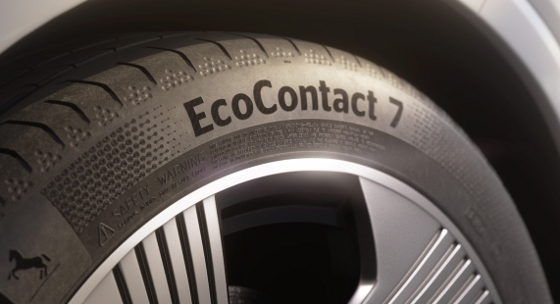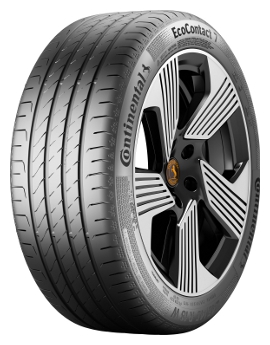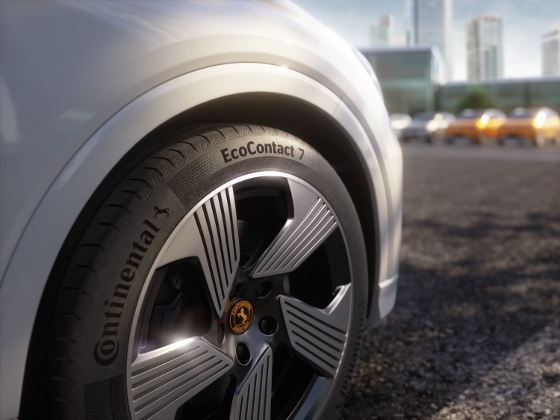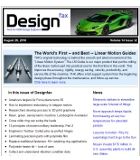 |
| February 11, 2025 | Volume 21 Issue 06 |
Designfax weekly eMagazine
Archives
Partners
Manufacturing Center
Product Spotlight
Modern Applications News
Metalworking Ideas For
Today's Job Shops
Tooling and Production
Strategies for large
metalworking plants
New tires add golf ball dimple tech for efficiency

[Credit: Image courtesy of Continental]
Engineers at mobility tech company Continental increased the overall efficiency of their new EcoContact 7 and the EcoContact 7 S (sport) automobile tires by using a new rubber compound, new casing technology, and knowledge gained from the sport of golf.
The tires are ideal for electric vehicles (EVs) but can also reduce the fuel consumption of internal combustion vehicles. In EU tire label measurements, the two new EcoContact models predominantly achieve Class A for rolling resistance and Class A and B for wet braking and rolling noise.

[Credit: Image courtesy of Continental]
The tires use Continental's new Green Chili 3.0 tread rubber compound, which has been adapted to address particular characteristics -- efficiency, rolling noise, dry handling, and mileage -- for each EcoContact tire model. Debuted first on Continental's AllSeasonContact 2 tire line, the Chili Blend rubber compound is a combination of the company's most successful tire compounds. For the AllSeasonContact 2 tire, the Chili Blend consisted of Continental's five top compounds for both winter and summer driving. EcoContact 7 and EcoContact 7 S contain their own special blends.
With the EcoContact 7 compound, Continental has focused on particularly low rolling resistance, which ensures its high energy efficiency. The tread compound of the EcoContact 7 S ensures improved wet grip and handling. The sportier version also offers greater steering precision and a higher grip level.
With both models, Continental is able to meet the different needs of various vehicle manufacturers and drivers of all drive types. Their special efficiency, low rolling noise, and high mileage also make the EcoContact 7 and EcoContact 7 S the ideal summer tire solution for electric vehicles. Both models are marked with the Continental "EV Compatible" logo on the sidewall, which explicitly recommends the tires for use on electric vehicles.
When specifically looking at improving the tire dynamics, the company's engineers got inspired by golf balls, which are equipped with 300 to 450 small dimples. These reduce air resistance and, at the same time, ensure greater lift and a longer and more precise flight. Continental transferred this concept to the sidewalls of the tires and developed what they are calling an "Aerodimple" structure. The dimples embedded in the tire sidewall reduce the air turbulence behind the tire so that the vehicle has to use less energy to move the tire.
[Side note: Golf ball dimple tech is also being used in designing rocketry (see "Can golf ball dimple tech help rockets fly better?" in Designfax here.)]

[Credit: Image courtesy of Continental]
Continental also developed a tread with something called the Silent Pattern for the EcoContact 7 and EcoContact 7 S to help reduce road noise -- especially to support the quiet rolling of EVs without engine noise, as well as combustion vehicles with particularly quiet engines. For this purpose, the spacing of the tread blocks and the angle of the blocks were optimized at the same time.
The resulting tread design is ideally matched to the frequencies that normally occur at speeds of around 50 km/h (31 mph), which keeps the tire noise to a minimum in residential and city areas.
The tire designers also used the Smart Energy Casing technology that Continental is using in its current AllSeasonContact 2 tire. It uses a new material that leads to less friction inside the tire and in the tire carcass. The EcoContact 7 and EcoContact 7 S also use the new material in the tire inner layer and tire wall. This reduces friction inside the tire, thereby lowering rolling resistance and increasing energy efficiency.
Designfax follow-up
After a few reader inquiries, we asked Continental if it could clarify and quantify the effect the sidewall dimpling has on the overall efficiency of the tires. They sent the following reply with new, interesting details:
While it turns out we cannot provide specific data points on efficiency, we are able to share the following three statements:
- The design of the sidewall has a major influence on the aerodynamics of a tire and thus on the overall efficiency of a vehicle. Continental's tire development department has been working on optimizations for many years and has already made significant progress in the past tire generations. This has been achieved, for example, by generally reducing all projections or smoothing the sidewall as much as possible and by designing the sidewall print inwards. All of these measures have been shown to result in significant flow benefits.
- The introduction of the Worldwide harmonized Light vehicles Test Procedures (WLPT) as an internationally standardized test procedure for determining vehicle exhaust emissions has further increased the importance of tire aerodynamics. In direct cooperation with vehicle manufacturers, Continental is therefore researching further optimization possibilities and carrying out corresponding wind tunnel measurements and simulations. These show that aerodynamic adjustments to the tire have a significant effect especially at high speeds of around 130 km/h and above. At lower speeds, the effect decreases exponentially. As a result, the effects of modifications are highly dependent on individual driving behavior and the vehicle itself, and cannot be quantified across the board.
- In the development of the EcoContact 7 and EcoContact 7 S, Continental combined proven aerodynamic improvements such as an extra smooth sidewall with knowledge gained from golf. The sidewall is designed with differently sized grooves to reduce air turbulence behind the tire during driving. Simulations during the development of the tire demonstrated the positive aerodynamic effect of this measure.
Source: Continental
Published February 2025
Rate this article
View our terms of use and privacy policy
